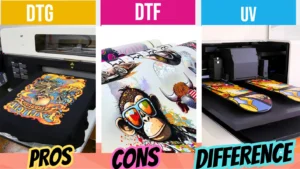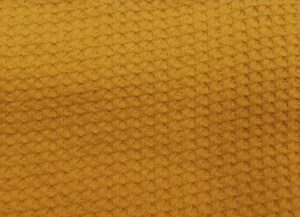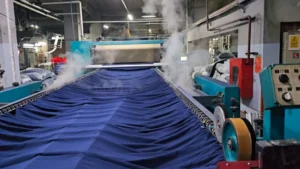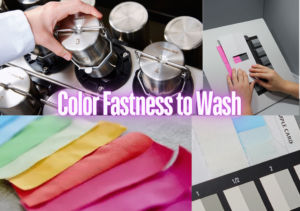Reactive dyeing process and method:
The reactive dyeing process and method stand as a cornerstone, deploying reactive dyes that form enduring covalent bonds with the fabric through a chemical reaction. This intricate procedure of reactive dyeing encompasses various processes and methods, each contributing to the vibrancy and permanence of the final coloration. Unlike traditional methods, where colors merely adhere to the surface, it creates brilliant and long-lasting colors. Reactive dyeing forms a permanent bond with the fabric, resulting in vibrant and enduring hues. This system incorporates transition molecules that facilitate a seamless connection between the dye and the fibers, ensuring not only a vibrant spectrum but also excellent colorfastness.
In a previous article we have covered the basics in a reactive dyeing system. Before going through this article one must check out the article entitled “Reactive Dyeing in textile: mechanism, Classification and steps.”
Necessity of reactive dyeing systems:
In today’s world we are using different types of dye in the textile industries. Till 1950, the dyes manufactured were not directly bonded to the fiber. Vat or Sulphur dyes required reducing and oxidizing process in addition. Direct dyes involved weak bonds only. Disperse dye, mainly for MMF, still by force swelling of fiber needed. Acid & Basic dyes introduced salt linkage & mordanting for cellulose. Azoic dye consists of multiple steps for color developing.
In 1955, Rattee and Stephen (ICI, UK), developed a dyeing system for cellulose with di-chlorotriazine group which ensured direct covalent bond.
Reactive Dyeing process of Cold brand reactive dye:
Typical Recipe For Cold brand reactive dye
| Dyestuff | 3% |
| Salt | 60 gm/l |
| Soda Ash | 15 gm/l |
| M:L | 1:10 |
| Temperature | 600C |
| Time | 1 hour |
Dyeing curve for Cold brand reactive dye
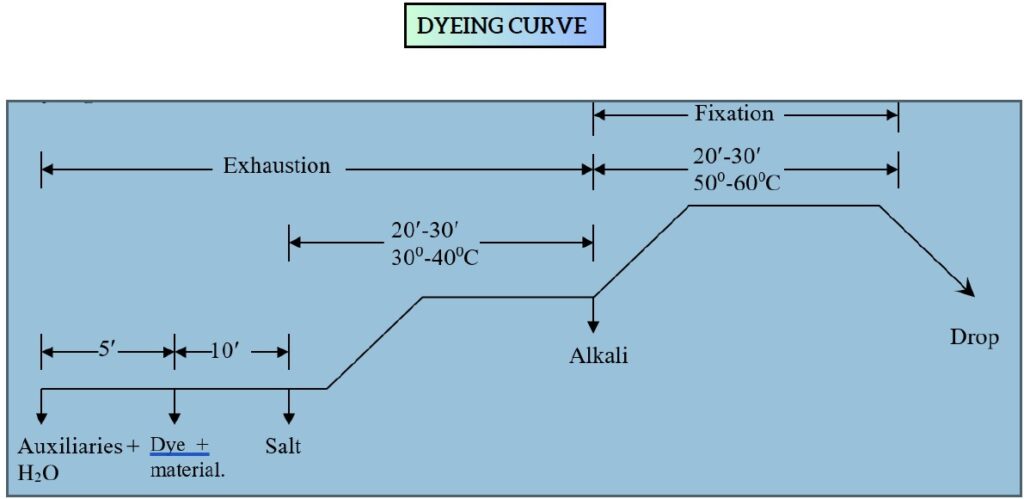
Dyeing Procedure:
Following the dyeing curve, begin by introducing auxiliaries and water into the dye bath, allowing it to keep for 5 minutes. Subsequently, add the material, followed by the dye. After a time frame of about 10 minutes, introduce salt into the dye bath. Once the salt is added, heat the dye bath to a temperature range of 40-50°C and maintain it for 20-30 minutes, representing the exhaustion phase of the dyeing process. Then, introduce alkali into the dye bath, and following this addition, heat the bath for approximately 40-60 minutes at a temperature range of 50-60°C, marking the fixation period.
After Treatment:

- Once the dyeing process is complete, immerse the dyed material in a bath containing 1% stock solution of acetic acid. This stage is crucial for neutralizing the fabric and is carried out at a temperature of approximately 60°C for a duration of 10 minutes.
- Subsequently, treat the material with a solution of 1 gm/l soap. This treatment effectively removes any unfixed dye from the fabric surface, ensuring a clean and vibrant appearance.
- Following the soap treatment, immerse the material to a hot water bath.
- As the next step, immerse the material in a cold-water bath, contributing to the overall post-dyeing treatment.
- Finally, complete the process by drying the material in a drier, ensuring the completion of the dyeing and treatment operations.
Dyeing Sequence:

Reactive Dyeing process of hot brand reactive dye:
Typical Recipe For hot brand reactive dye
| Dyestuff | 4% |
| Salt | 80 gm/l |
| Soda Ash | 20 gm/l |
| M:L | 1:15 |
| Temperature | 500– 90oC |
| Time | 1 hour |
Dyeing curve for hot brand reactive dye
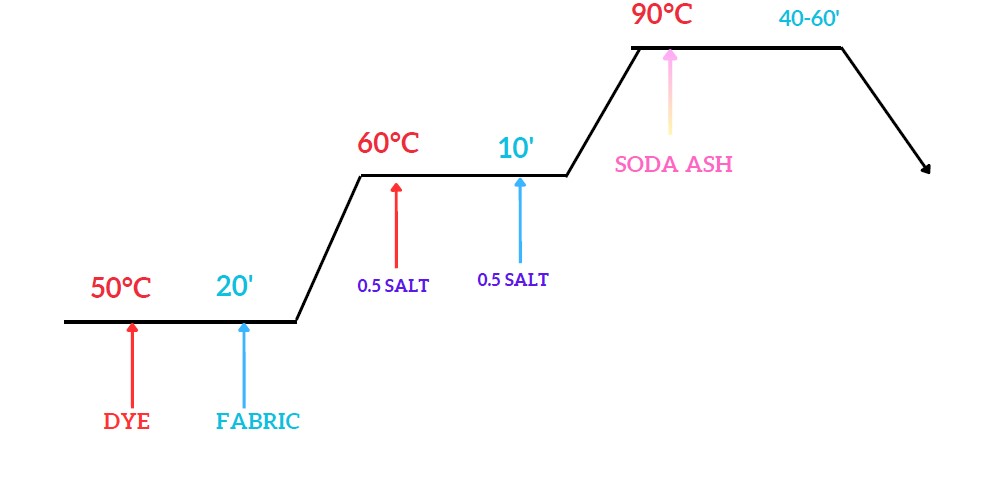
Dyeing procedure:
Commencing the dyeing process, initiate by preparing a paste with cold water and dye. Subsequently, create a dye solution using hot water. Adjust the dye bath to a temperature of 50°C, introducing the dye solution, and immerse the fabric for approximately 20 minutes. Gradually raise the temperature to 60°C.
Proceed by adding half of the required salt to the dye bath and dyeing for 10 minutes. Follow this by incorporating the remaining half of the salt into the bath and continuing the dyeing process for an additional 30 minutes. Raise the temperature to 90°C, introduce soda ash, and dye for a duration ranging from 40 to 60 minutes.
Subsequent to the dyeing phase, perform washing cycles with cold water and hot water. Move on to the soaping stage using a detergent solution with a concentration of 2 gm/l. Conclude the process with a final cold wash, ensuring the thorough completion of the dyeing and treatment operations.
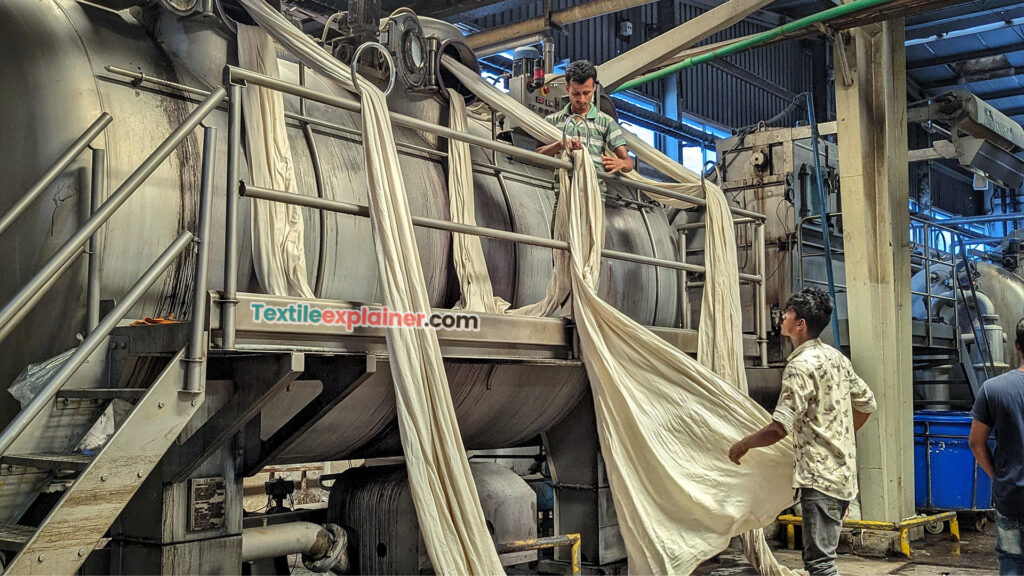
Dyeing Sequence:

Typical dyeing conditions:
1. Bi-functional MCT (Mono-chloro-triazine) dye:
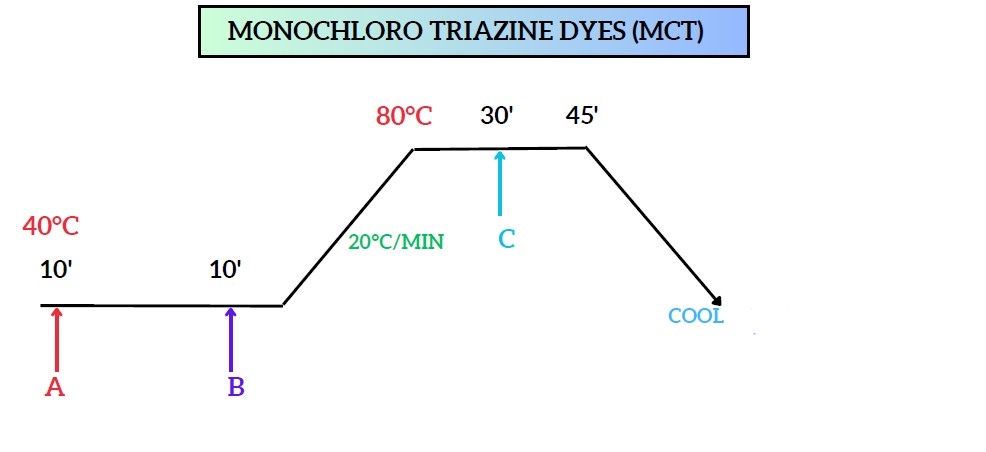
A= Materials + 2% OWF(On the Weight of Fabric) dye solution
B= Salt (Na2SO4) (60gm/l)
C= Alkali (Na2CO3) (20gm/l)
2. Bi-functional DCT (Di-chloro-triazine) dye:

A= Materials + 2% OWF(On the Weight of Fabric) dye solution
B= Salt (NaCl) (35gm/l)
C= Alkali (Na2CO3) (4gm/l)
3. Vinyl Sulphone(VS) dye:
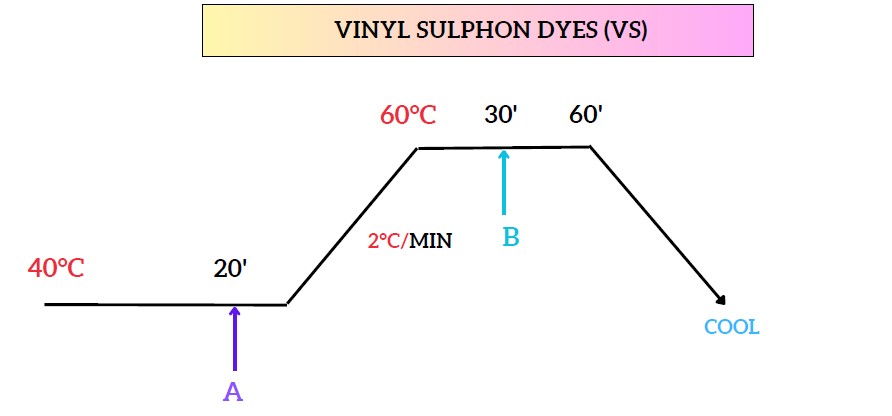
A= Materials + 2% OWF(On the Weight of Fabric) dye solution + Salt
B= Alkali
4. Bi-functional Sulphatoethyl Sulphone dye:
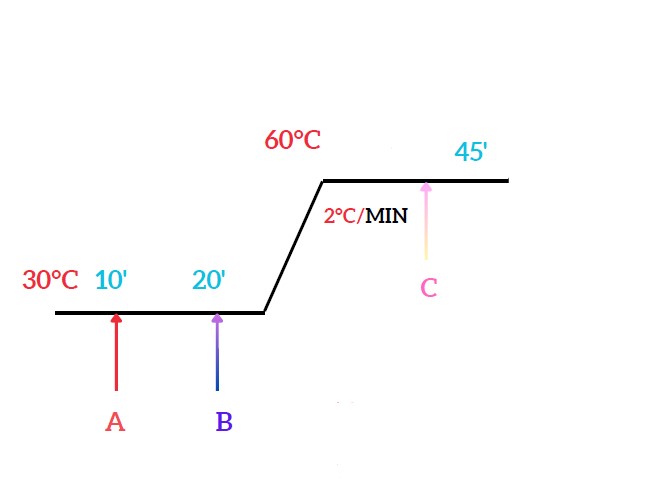
A= Materials + 2% OWF(On the Weight of Fabric) dye solution
B= Salt (NaCl) (50gm/l)
C= Alkali (Na2CO3) (20gm/l)
5. Mixed Bifunctional Dyes (MCT + VS):
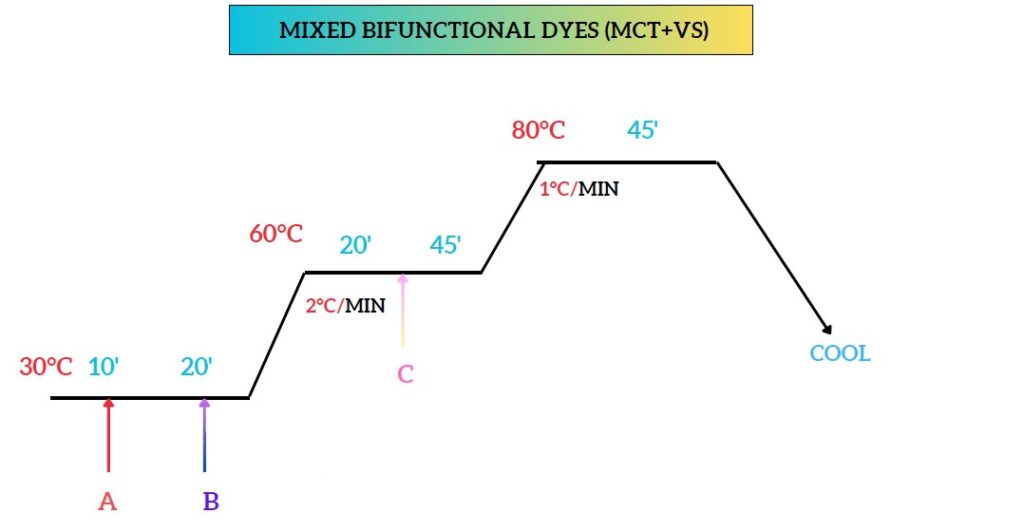
A= Materials + 2% OWF(On the Weight of Fabric) dye solution
B= Salt (NaCl) (50gm/l)
C= Alkali (Na2CO3) (20gm/l)
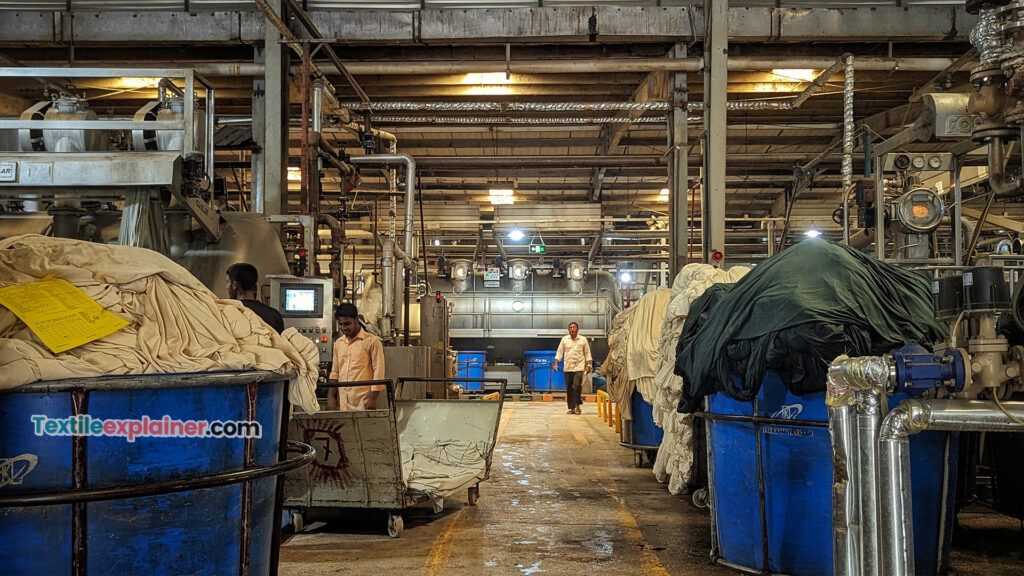
Methods of reactive dyeing:
- Continuous – Pad-Thermofix.
- Semi continuous- Pad-Batch, Pad-Jig
- Dis-Continuous or Batch wise exhaustion – Winch (knitted fabric), Jet (knitted + woven fabric), Jigger(woven fabric), Package & Beam dyeing.
Pad Batch Method:
Typical Recipe For Pad Batch Method:
| Dyestuff | 3% |
| Salt | 60 gm/l |
| Soda Ash | 15 gm/l |
| Urea | 150 gm/l |
| Sodium(Na) alginate | Approximate amount |
Procedure Of Pad-Batch (cold) method:
In the Pad-Batch (Cold) process, initiate by padding the fabric in a bath containing dye, alkali, and salt at room temperature. It’s crucial to maintain a constant temperature to prevent variations in shade. After padding, wrap the batches in a polyethylene sheet and store them at room temperature for 1-24 hours. During this storage period, ensure that the rolls are slowly rotating to prevent seepage of dye liquor. Once the required batching time has elapsed, wash the cloth in an open-width washer.
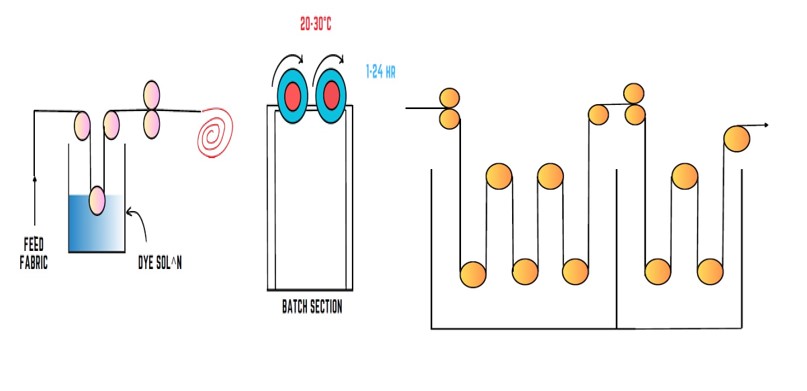
Procedure Of Pad-Batch (Hot) method:
For the Pad-Batch (Hot) processes, employ a milder alkali in the pad bath. Prepare the fabric by padding it with dye and alkali, passing it between infrared heaters to preheat the padded fabric to a temperature range of 50 to 95°C. Subsequently, batch the fabric on a large-diameter roller in a heat chamber. The batching is conducted under controlled conditions of temperature and humidity for a sufficient duration, ensuring the diffusion and fixation of the dye in the fiber. Throughout this period, keep the batch slowly rotating to prevent seepage of dye liquor. Afterward, remove the cloth for washing.
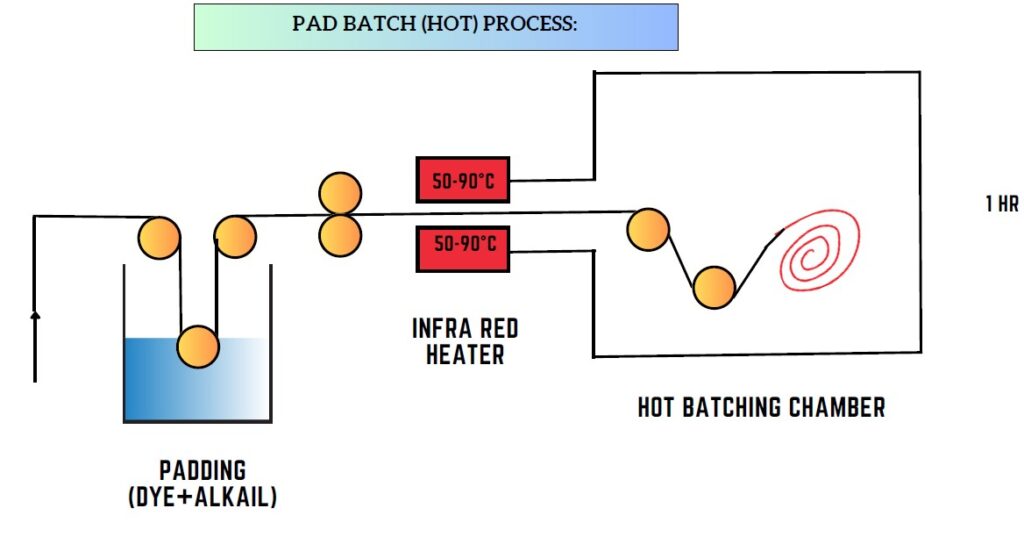
Continuous method:
Procedure Of Continuous method (Pad Steam):
In the Pad Steam Method, commence by padding the fabric with the dye solution at temperatures between 60°C and 80°C. Subsequently, pass the fabric through a drying chamber. Following this, pad the fabric with a chemical solution (NaOH + Salt). Then, pass the fabric through a steam chamber at temperatures ranging from 100°C to 102°C for 30-60 seconds. Finally, wash the fabric in an open-width washer.

Reference:
- Cellulosics Dyeing Edited by John Shore
- Basic Principles of Textile Coloration – Arthur D. Broadbent
- Textile Preparation and Dyeing by A K Roy Choudhury
- Dyeing and Chemical Technology of Textile Fibers by E.R. Trotman
